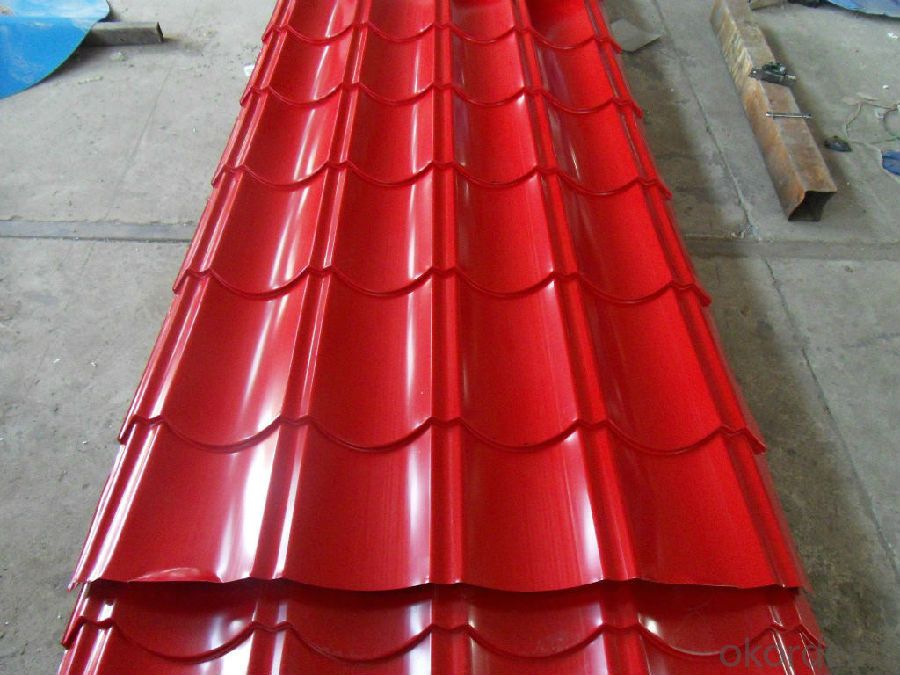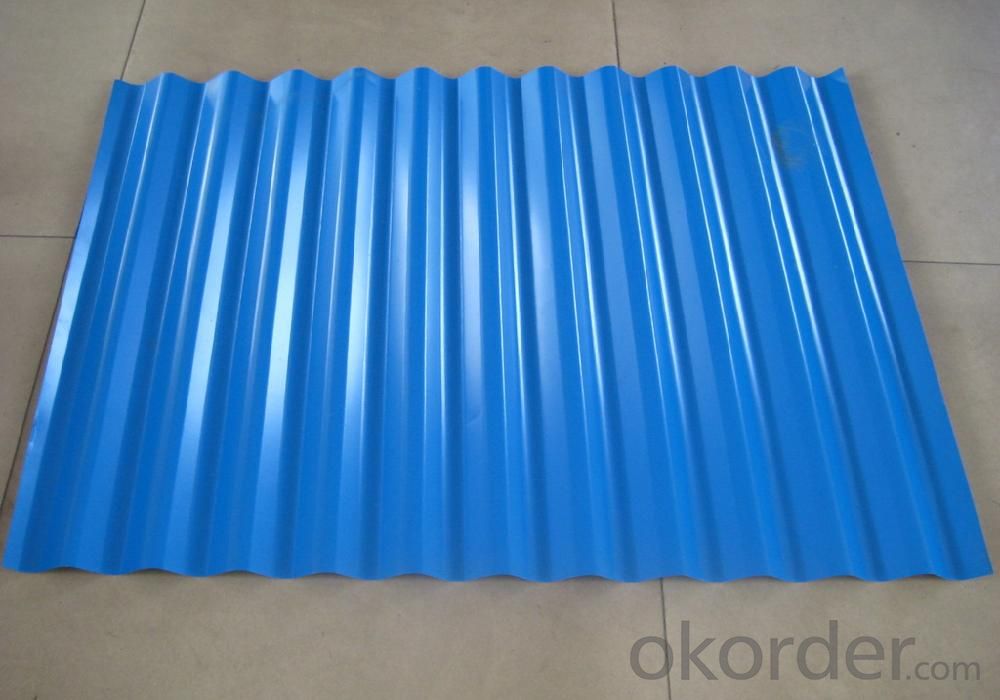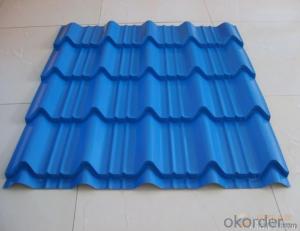Pre-Painted Galvanized/Aluzinc Steel Roof with Best Price of China
- Loading Port:
- Shanghai
- Payment Terms:
- TT OR LC
- Min Order Qty:
- 50 m
- Supply Capability:
- 10000 m/month
OKorder Service Pledge
OKorder Financial Service
You Might Also Like
1. Pre-Painted Galvanized/Aluzinc Steel Roof Description:
With GI as base material, after pretreatment (degrease and chemical treatment ) and liquid dope with several layers of color, then after firing and cooling, finally the plate steel is called pre-painted galvanized (aluzinc) steel. Pre-painted galvanized roof is good capable of decoration, molding, corrosion resistance. It generally displays superior workability, durability and weather resistance.
2.Main Features of the Pre-Painted Galvanized/Aluzinc Steel Roof:
• Excellent process capability
• Smooth and flat surface
• Workability, durability
• Excellent heat resistance performance
• High strength
• Good formability
• Good visual effect
3.Pre-Painted Galvanized/Aluzinc Steel Roof Images


4.Pre-Painted Galvanized/Aluzinc Steel Roof Specification
Standard: AISI, ASTM, BS, DIN, GB, JIS
Grade: SGCC SGCH SGCD DX51D
Thickness: 0.13-3.0mm
Model Number: AISI, ASTM, BS, DIN, GB, JIS
Type: Steel Plate
Technique: Cold Rolled
Surface Treatment: Galvanized
Application: Container Plate
Special Use: High-strength Steel Plate
Width: 30-1500mm
Length: any length
color: RAL color
5.FAQ of Pre-Painted Galvanized/Aluzinc Steel Roof
What’s the brand of the paint?
We use the best brand of all of the word—AKZO.
What’s the wet and heat resistance of the roof?
More than 1000 hours.
- Q:in a lab at school we did heat treatment of steelwhat are the possible phases present in the steel sample in as-received, as-quenched and as-tempered conditions? specifically when is it ferrite, austenite and pearliteis the steel originally in the ferrite phase? then when headed turns into austenite and when quenched martensite is formed and when tempered cermentite is formed...........where is pearlite involved and am i correct about the ferrite?
- hey from what i learned in uni last sem, steel is originally ferrite form at first at room conditions. it will undergo poly morphic transformation to become FCC structure austenite form at 912 degree celcius. under conditions, it can become pearlite (which is a combination of ferrite and cementite) or bainitie( a finer form of pearlite). queching conditions to room temperature will form martensite which is the strongest but brittle steel form. tempered cementite is formed when we quench it and then raise temperatures before sir cooling. hope it helps, pls vote me best answer is i deserve it. thanks
- Q:what pokemon are week to steel type pokemon like lucario? help please, and thank you.
- Ground type pokemon are weak to steel.
- Q:Has anyone painted their appliences with stainless steel paint? I found on the internet what is called Thomas Liquid stainless steel paint. If you have used it for your kitchen appliences or cabinets, how were the results? How hard was it to apply? Would you recommend it?
- If okorder /
- Q:i need some ideas of what material could replace iron or steel to make fridges, stoves, dishwashers, tractors, aircrafts, cars and buses and anything else that is made of iron and steel. anything is greatly appreciated as at the moment i have no idea what to put down.
- Material selection is a complex area. Iron and steel are very good materials in terms of their strength, stiffness and hardness (especially when compared to their density to give specific strength/stiffness. They are also relatively cheap and the economics of material selection is often the over-riding criteria. Each individual substitution has to be considered on the merits of what the component has to do and the environment in which it operates and often to replace steel with, say, aluminium, might not be appropriate or might require a redesign of the component to accomodate the lower strength and stiffness. Take one of your examples of a dishwasher; To replace the (cheap and thin) steel outer casing with aluminium would require thicker sheet to achieve the same stiffness. To replace the stainless steel inner you would need a corrosion resistant material (which rules out aluminium) which can be easily fabricated to shape. Nickel alloys would be harder to process and very expensive, but you might be able to use a bronze alloy. If you have time look in the library for a book on materials selection by Ashby - one of the best texts on the subject.
- Q:How are steel coils coated for color and aesthetics?
- Steel coils can be coated for color and aesthetics through a process called coil coating. This process involves applying a layer of paint or coating material to the surface of the steel coil to enhance its appearance and provide protection against corrosion. The coil coating process typically begins with a thorough cleaning and pre-treatment of the steel surface. This step ensures that the surface is free from any contaminants and provides a suitable base for the coating to adhere to. The pre-treatment process may involve cleaning, degreasing, and chemical treatment to enhance the adhesion and durability of the coating. Once the surface is prepped, the coil is then fed through a continuous coating line. In this line, the coating material, which is usually a liquid paint, is applied to both sides of the steel coil using various methods such as roll coating, spray coating, or electrostatic coating. The coating material is carefully selected to provide the desired color, texture, and durability. After the coating is applied, the coil goes through a curing process, where it is heated to allow the coating material to dry and bond to the steel surface. This ensures a strong and durable finish that can withstand exposure to various environmental conditions. Coil coating technology also allows for additional treatments to enhance the aesthetics of the steel coil. For example, the coil can undergo a process called embossing, where a pattern is embossed onto the surface, giving it a textured or three-dimensional appearance. Additionally, other decorative techniques like printing, laminating, or adding metallic effects can be employed to achieve specific aesthetic effects. Overall, the coil coating process not only adds color and aesthetics to steel coils but also provides a protective layer that increases their lifespan and resistance to corrosion. This makes them suitable for a wide range of applications, including roofing, automotive parts, appliances, and construction materials.
- Q:Hi can someone help me pleaseis there any available data for mechanical behaviour of recycled steel, i need to compare them with new steel.
- It is not clear from the question whether the recycled steel is used in its existing state or used as raw material for further fabrication. For the existing steel, you need to track down the original documents such as the ladle analysis and mill certificates certifying the material standards for which the steel was fabricated. Another alternative is take samples and conduct chemical and mechanical tests on the steel. Also the date of when the structure was built from which the steel is recycled may help indicate whether it is (American Society for Testing and Materials) Standard ASTM A7 or ASTM A36 or another type of steel. In most cases, the steel is used as raw material to make new steel. The mill will adjust the additives to produce steel with the required chemical and physical properties to meet the ASTM standards specified.
- Q:I have one and wonder how much force this can take since it does seem like you can bend it(Sure it's impossible with hands), but I don't want to try that cause i don't want to break it. Many people say that it's really hard and can handle a hammer smash? is that true and can it even make it through more force. Cause steel is harder than iron and iron is pretty hard... So how much can i trust this locks security, i mean if i put at at a door would some thiefes be able to break it, if they had the right tools??
- any pair of larger bolt cutters would whack right thru that lock brother. use it, but put a backup lock on somewhere else too. thx for the pic!
- Q:Just wondering how good are forge steel screw drivers, tool boxes(organisers) and pliers are, as screw fix are having a january sale, and looking to add to my tool collection. Thanks in advance
- forged steel is a trick to get people like you who know nothing of steel to think of a blacksmith hammering away at a anvil making great tools. Not to say they are bad they are probably fine. but forged just means it was made when the steel was hot, it says nothing of the quality of steel in the process. however whenever steel is forged it will be stronger than the same product made out the same steel, but shaped by machining process.
- Q:What are the different types of steel coil processing equipment?
- In the manufacturing industry, various types of steel coil processing equipment are utilized. These equipment are specifically designed to handle and process steel coils in different ways, enabling efficient and precise production. Some commonly used steel coil processing equipment are as follows: 1. Decoilers: These machines are employed to unwind steel coils and feed them into the processing line. Equipped with motorized systems, they ensure a steady supply of material by controlling the unwinding process. 2. Straighteners: The purpose of straighteners is to flatten and straighten steel coils that may have become distorted during the coiling process. By utilizing a series of rollers, they eliminate any bends or waves, guaranteeing a smooth and consistent feed to the next processing stage. 3. Slitters: Slitters are responsible for cutting steel coils into narrower strips, allowing the production of various widths of steel sheets or strips. They consist of multiple sets of adjustable circular blades used to achieve the desired width. 4. Levelers: Levelers are utilized to correct any surface imperfections in steel coils, such as wavy or undulating surfaces. By means of a series of rollers, they apply pressure and reshape the material, resulting in a flat and uniform surface. 5. Shears: Shears are used to precisely cut steel coils into specific lengths. They can be either hydraulic or mechanical and are designed to provide clean and accurate cuts, ensuring the desired dimensions are achieved. 6. Recoilers: Recoilers are essential for rewinding processed steel coils back into tightly wound coils. They can be either motorized or manual and are crucial for storage and transportation purposes. 7. Edge trimmers: These machines are employed to remove any excess material from the edges of steel coils. By ensuring a clean and consistent edge, they enable better handling and further processing. 8. Coil cars: Coil cars are utilized for the transportation of steel coils within the processing facility. They are equipped with hydraulic or mechanical systems, facilitating easy loading and unloading of coils onto other equipment. These represent only a few examples of the diverse range of steel coil processing equipment used in the industry. Each piece of equipment plays a vital role in the manufacturing process, ensuring the efficient production of high-quality steel products.
- Q:I am refinishing a table and on my can of polyurethane, it indicates not to sand with steel wool prior to application. Why is that?
- it can turn dark! use 400 to 600grit wetdry sandpaper watch your edges!!!
1. Manufacturer Overview |
|
|---|---|
| Location | |
| Year Established | |
| Annual Output Value | |
| Main Markets | |
| Company Certifications | |
2. Manufacturer Certificates |
|
|---|---|
| a) Certification Name | |
| Range | |
| Reference | |
| Validity Period | |
3. Manufacturer Capability |
|
|---|---|
| a)Trade Capacity | |
| Nearest Port | |
| Export Percentage | |
| No.of Employees in Trade Department | |
| Language Spoken: | |
| b)Factory Information | |
| Factory Size: | |
| No. of Production Lines | |
| Contract Manufacturing | |
| Product Price Range | |
Send your message to us
Pre-Painted Galvanized/Aluzinc Steel Roof with Best Price of China
- Loading Port:
- Shanghai
- Payment Terms:
- TT OR LC
- Min Order Qty:
- 50 m
- Supply Capability:
- 10000 m/month
OKorder Service Pledge
OKorder Financial Service
Similar products
New products
Hot products
Related keywords





























